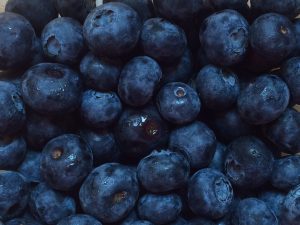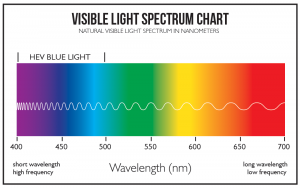Speaking of fruits, how many kinds of blue fruits can you come up with? A recent research conducted in Xishuangbanna Tropical Botanical Garden located in Yunnan, China has shown that, amongst the over 600 species of fruits growing in the garden, only 6 types of fruits are blue. How did this come about? There are a variety of aspects that we need to look at in order to answer this question.

Blueberries
credit: https://thescooponbaking.files.wordpress.com/2015/07/fullsizerender_1.jpg
Where do colours in fruits come from?
Fruits get their colours from three main types of plant pigments: carotenoids for colours red, orange and yellow, flavonoids for blue and red, as well as chlorophyll for green colour. Due to the fact that colour red is the most common hue among the three chemicals, most fruits are red.
Colours of fruits and their reproduction
The reason why we are able to identify different colours is that the wavelengths of these colours can be perceived by a specific type of cells called cones in our eyes. Some animals see more colours than we do because they can detect a wider range of wavelengths in the nature. However, when reacting to different colours, cone cells show different levels of sensitivity to their wavelengths, and the colour blue is, unfortunately, not as visible as other colours to most animals.

Credit: https://www.quora.com/Why-is-red-on-the-right-of-the-light-spectrum-and-purple-on-the-left
Lower visibility of blue fruits leads to lower probabilities that they get spotted and eaten by animals and consequently have their seeds spread, which is an important method of reproduction for most plants. As a consequence, blue fruits can not be spread as easily and frequently as fruits with other colours such as red and orange.
However, while the colour blue gives these fruits a hard time to reproduce, there also exist some animals that are inherently colourblind. These animals spot and eat fruits randomly instead of by identifying colours, and this is also the reason why there is still a small amount of blue fruits we can find in our everyday life nowadays.
Additionally, another factor that should be taken into account is that, because it is always connected with characteristics such as danger, the colour blue can result in a loss of appetite in animals.
(video credit: https://youtu.be/l04dn8Msm-Y)
Overall, the shortage of blue fruits is due to a number of reasons. Specifically, the uneven distribution of pigments in different species of fruits and some special characteristics of the colour blue are the two main factors that account for this phenomenon to a great extend.
– Siqi Tao
